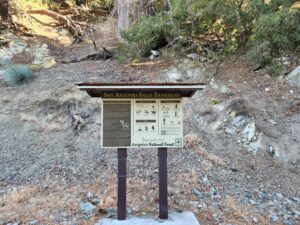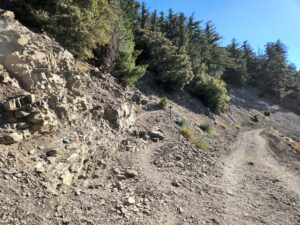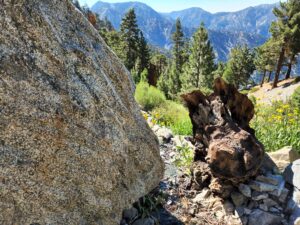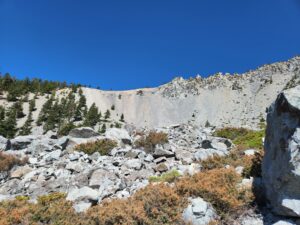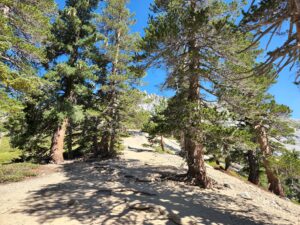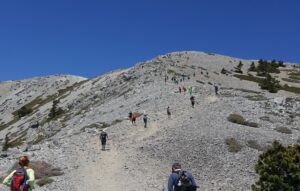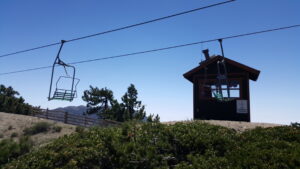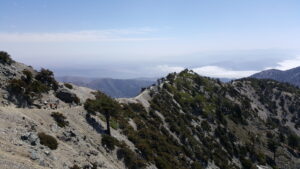
Objective: Summit Mt. Baldy, San Gabriel Mountains, California
Distance: 11 miles (clockwise loop)
Peak Elevation: 10,064′
Elevation Gain: 3,800′
Difficulty: Strenuous
There are a number of ways to approach Mount Baldy. You can take the Old Baldy Trail, the Ski Hut Trail, or the Devil’s Backbone. Why not combine some of the routes into a big loop? In this clockwise loop, you take the Ski Hut Trail to the summit, follow the Devil’s Backbone to the Notch, and take the fireroad back to the trailhead.
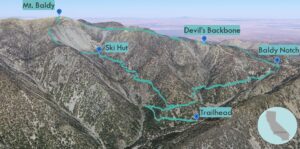
Directions to Trailhead
Head east on the 210, and exit Baseline Road in Claremont. Turn left on Baseline Road. Make a right on Padua Avenue and continue for 1.8 miles. Turn right onto Mt. Baldy Road and drive for 11.5 miles past Mt. Baldy Village. Make a left at Falls Road. Turn left again at Mt. Baldy Road and find parking on the side of the street above Manker Flat campground.
Directions to Summit
Start: Begin at Falls Road and head past the gate.
0.5 miles: At the waterfall lookout, the Baldy fire road begins.
1.0 mile: At the junction, turn left up the steep Ski Hut Trail (Baldy Bowl trail).
2.6 miles: After the Ski Hut, the trail reaches the ridge and ascends to the summit.
4.5 miles: You have reached Mt. Baldy. Follow the Devil’s Backbone Trail.
7.5 miles: Baldy Notch is at the top of the ski lift.
11 miles: You have returned to the trailhead.
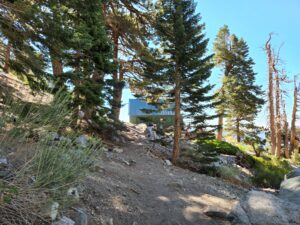
Trek Highlights
At the end of Falls Road, the path makes a big U-turn at San Antonio Falls. Later along the fire road, you need to look closely for the Ski Hut trail junction. The narrow trail climbs north straight up the side of San Antonio Canyon. After crossing the spring, a spur trail leads to the Ski Hut by the base of the Baldy Bowl. (Instructions for making a reservation when the Ski Hut is open, can be found here.)
Above the Ski Hut, the trail hits a rocky patch. It then ascends over a dozen little switchbacks at the western edge of the Baldy Bowl. Upon gaining the ridgeline, there is a mile-long final push to the top of the summit.
Mount San Antonio is known as “Baldy” because there are no trees on the bare southern face of the mountain. At the peak, there are some windbreaks next to the famous metal summit plaque. From here, you can enjoy views of the other high peaks of the back range of the San Gabriel Mountains.
As you descend to the east, the route splinters into several steep use trails. When the path levels off, the Devil’s Backbone Trail becomes a narrow ridgeline spine with significant drop-offs on each side.
All of a sudden, you can see Baldy Notch. The Top of the Notch restaurant and bar is in a perfect place to rest and refuel.
From the Notch, you can cheat and take the ski lift down. Otherwise, the way back is a wide and level fire road back to the trailhead.
If time is limited, consider hiking to Mt. Baldy via the Ski Hut Trail as an out and back. Or climb Mt. Baldy via the Devil’s Backbone as an out and back, with or without the ski lift.
Red Tape
An Adventure Pass is required for each vehicle parked along the roadside.
Photos
